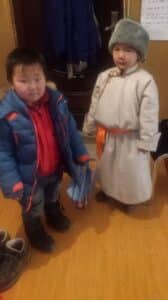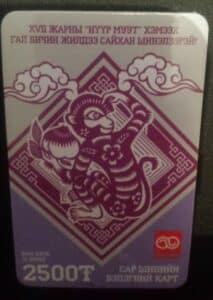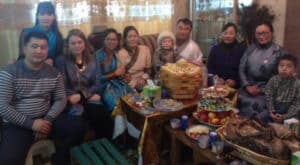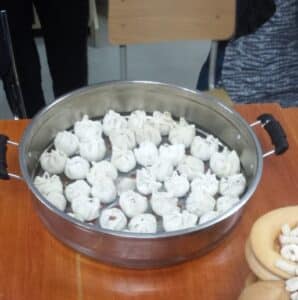Lunar New Year in the Most Sparsely Populated Country in the World
Hello! Your Friendly Neighborhood Operations Manager here. My name is Kira Lemons and I keep the gears turning at Carpe Global, but I haven’t always been here. In 2015 I traveled to Mongolia to serve two years with the Peace Corps as a Teacher Trainer in their English Education program.
Working with Mongolian English Teachers and getting to know my small-town community were amazing bonding experiences and I’m so glad I volunteered. One of the best ways to get to know more about Mongolian tradition and culture is during national holidays and one of the biggest ones is called Цагаан сар [tsagaan sar], also known as the Lunar New Year, which takes place in February or March. Below is my experience during my first year of service, as taken from my blog: https://blueskiessmilin.wordpress.com/
There are 2 major traditional Mongolian holidays. One of them is the summer sports festival called Naadam. The other is the Lunar New Year, known in Mongolia as Tsagaan Sar or White Moon/Month.
In order to prepare for the festivities, families mob the grocery stores, clean house, make (sometimes literally) thousands of buuz (steamed meat dumplings), and buy new deel (traditional clothing) or get their finest ones ready. The mobbed store I got to experience for myself, as I was sick the second weekend before Tsagaan Sar and couldn’t get my shopping done then. Almost all the stores in the countryside are pretty small and if the space itself isn’t, the space left from shelving and stacked merchandise is. It was like grocery shopping the weekend or day before Thanksgiving. Outdoors, it was still well below freezing, but as I was standing in line, I could feel the sweat soaking into my thermals, shirt, fleece, and jacket.
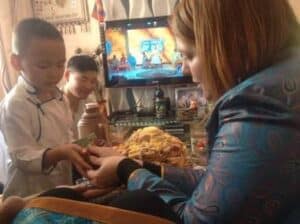
Passing a (practice) snuff bottle back to a young boy.
The night before the event, Lunar New Year’s Eve, the close family members spend time together and may visit their closest relatives, usually the head of the family or the brothers and sisters of the parents. The next day begins three days of drinking, eating, giving and receiving presents, small children coming around to collect money and candy, house hopping, and trying to recover enough to do it all again the next day.
Two of the many children who visited my house.
One of the presents I got for visiting houses, a card with credits to add to my phone.
Tuesday went well, I visited two or three homes and had more than my fill of buuz, mayonnaise-based salad, mutton, airag (fermented horse milk), and candy. Wednesday started out well, but did not end that way. I ate and drank far too much to get away with anything less. At the second house (of three) I lost count of how much I had consumed and by the time I got home, I was doomed to a night of discomfort. Thursday I recovered enough to go to one house, but was very careful about how much I ate and drank.
Yin and I with the family of some of our teachers. The cookie tower’s height depends on the generation of the family hosting.
Also, the Agaa Egee (Big Brothers/Big Sisters-style mentorship club) at my school had a subdued version of Tsagaan Sar the Tuesday after the actual holiday. We steamed up some buuz, built our cookie tower, played shagai (games using sheep or goat ankle bones) and did some other fun activities.
Round 1 of school buuz (and one little bansh) ready for steaming.
Overall I’d say this Tsagaan Sar was a success. And I have learned a lot for next year. More houses and less consumption is the game plan. Hopefully I’ll have plenty of invites!
If you’d like to learn more about Mongolian food and culture, my friend Nargie has a YouTube channel called “ARTGER” all about it
If you want to travel to Mongolia and support and stay with nomadic herding families, check out “Ger to Ger”
If you’d like to learn more about Peace Corps activities in Mongolia, the official page is: Peace Corps Mongolia
Connect, explore, and become even more worldly at Carpe Global, where you can learn about great resources and opportunities like those shared above! Sign up for our newsletter and follow us on social media @carpeglobal.
Interested in becoming a guest blogger with Carpe Global? Contact Sarah Hyser at sarah.hyser@student.shu.edu with your ideas, and we’ll be in touch!
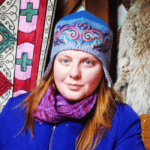
Kira Lemons
Kira is a recentgraduateof the MiddleburyInstituteof InternationalStudies atMontereywith a Master’s degree in International Education Management. Kira has spentmanyyears of her life living and workingabroad. She has worked for schools in Japan and Mongolia. More recently, Kira assisted with the University of California System’s first virtual study abroad fair. Kira is currently the operations manager here at Carpe Global.
